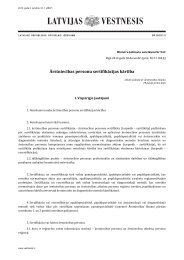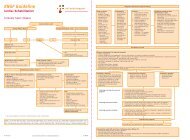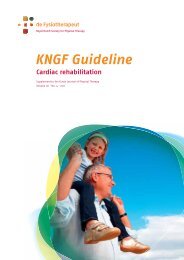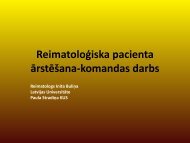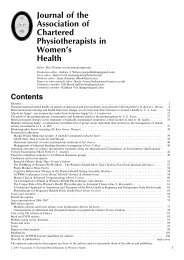Create successful ePaper yourself
Turn your PDF publications into a flip-book with our unique Google optimized e-Paper software.
<strong>Low</strong> <strong>Back</strong> <strong>Pain</strong>: Clinical Practice Guidelines<br />
care treatment for low back pain, the rate of serious pathology<br />
was quite low (0.9%), with most of the identified red<br />
flag cases, 8 of 11, being spinal fractures. 150 Because most patients<br />
had at least 1 red flag, Henschke et al 150 have cautioned<br />
against use of isolated red flags because of poor diagnostic<br />
accuracy. To improve diagnostic accuracy, a diagnostic prediction<br />
rule for identifying spinal fracture, which included<br />
being female, older than 70 years, significant trauma, and<br />
prolonged use of corticosteroids, was developed. 149<br />
In addition to medical conditions, clinicians should<br />
be aware of psychological and social factors that<br />
may be contributing to a patient’s persistent pain<br />
and disability, or that may contribute to the transition from<br />
an acute condition to a chronic, disabling condition. Researchers<br />
have shown that psychosocial factors are an important<br />
prognostic indicator of prolonged disability. 315<br />
I<br />
The term “yellow flags” is commonly used in the<br />
V literature to differentiate psychosocial risk factors<br />
for persistent pain from medical red flags. Identification<br />
of psychological factors is assisted with the use of<br />
standard questionnaires described in the Measures section<br />
of these clinical guidelines. When relevant psychological<br />
factors are identified, the rehabilitation approach should be<br />
modified to emphasize active rehabilitation, graded exercise<br />
programs, positive reinforcement of functional accomplishments,<br />
and/or graduated exposure to specific activities that<br />
a patient fears as potentially painful or difficult to perform.<br />
These approaches will be described in the Interventions section<br />
of these clinical guidelines. In addition, there should<br />
be standard processes so that clinicians screening for severe<br />
psychiatric disturbances (eg, clinical depression) have a clear<br />
indication of when referral for appropriate care is expected<br />
in a given clinical setting. An example of such a process can<br />
RED FLAGS FOR THE LOW BACK REGION<br />
a18 | april 2012 | volume 42 | number 4 | journal of orthopaedic & sports physical therapy<br />
be made with the Primary Care Evaluation of Mental Disorders<br />
tool that has been described for depressive symptom<br />
screening in physical therapy settings. 136 A patient with a<br />
positive screening result for major or severe depressive<br />
symptoms should receive a focused clinical interview and<br />
should complete a full-length depressive symptom questionnaire<br />
(eg, Patient Health Questionnaire or Beck Depression<br />
Inventory). A referral to a mental healthcare provider is indicated<br />
to confirm a depression diagnosis if the results of<br />
the interview and questionnaire provide further indication<br />
that major or severe depressive symptoms are present and<br />
the patient is unaware of this. An immediate assessment by<br />
a medical and/or mental health professional is indicated for<br />
safety reasons if the patient had a plan to harm himself/<br />
herself or others. A similar process could be used for clinicians<br />
who screen for other psychopathology (eg, anxiety).<br />
The authors of these clinical guidelines acknowledge that<br />
this is a general description for a rather important process.<br />
However, there are no absolute guidelines for the levels of<br />
psychological symptoms that indicate referral. Therefore,<br />
clinicians will have to work within their own clinical environments,<br />
using available resources, to ensure this screening<br />
is handled appropriately.<br />
Clinicians should consider diagnostic classifica-<br />
A tions associated with serious medical conditions or<br />
psychosocial factors and initiate referral to the appropriate<br />
medical practitioner when (1) the patient’s clinical<br />
findings are suggestive of serious medical or psychological<br />
pathology, (2) the reported activity limitations or impairments<br />
of body function and structure are not consistent<br />
with those presented in the diagnosis/classification section of<br />
these guidelines, or (3) the patient’s symptoms are not resolving<br />
with interventions aimed at normalization of the patient’s<br />
impairments of body function.<br />
Condition History and Physical Examination Data Sensitivity Specificity +LR (95% CI) –LR (95% CI)<br />
<strong>Back</strong>-related<br />
tumor 82,84,148<br />
Constant pain not affected by position or<br />
activity; worse with weight bearing, worse<br />
at night<br />
Odds Ratio<br />
(95% CI)<br />
... ... ... ... ...<br />
Age over 50 0.84 0.69 2.2 (1.8, 2.7) 0.34 (0.17, 0.68) ...<br />
History of cancer 0.55 0.98 23.7 (11.3, 49.4) 0.25 (0.01, 9.19) ...<br />
Failure of conservative intervention (failure to<br />
improve within 30 days)<br />
0.29 0.90 3.0 (1.4, 6.3) 0.79 (–0.58, 1.07) ...<br />
Unexplained weight loss 0.15 0.94 3.0 (1.0, 9.3) 0.87 (0.68, 1.12) ...<br />
No relief with bed-rest 1.00 0.46 1.7 (1.2, 2.2) 0.22 (0.02, 3.02) ...<br />
(continued)



